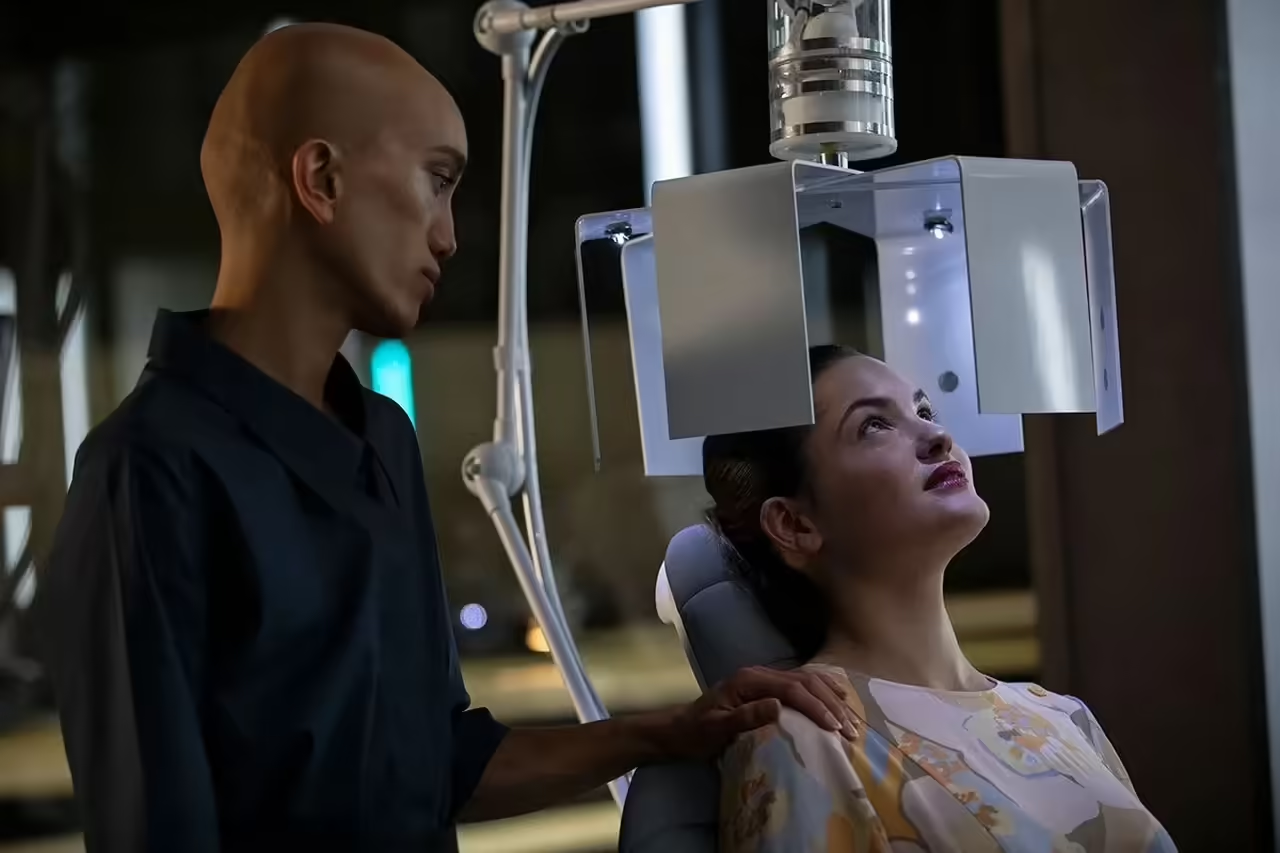
“Osmosis” is a French sci-fi series that premiered in 2019 on Netflix. The plot takes place in the near future where a revolutionary pairing technology called “Osmosis” has been developed. This technology promises to find the perfect partner for a person using an advanced algorithm and massive data collection.
The series explores the mysteries and ethical dilemmas that arise from this technology. Here are some key aspects explored in “Osmosis”:
Brain-based matching technology – Osmosis uses brain-scanning technology to collect data about individuals and understand their desires, fears and personality. By analyzing this information, the matching algorithm seeks to find the perfect match for each individual.
Privacy and consent: The series raises questions about the right to privacy and informed consent. To use Osmosis, participants must provide full access to their innermost thoughts and memories. This raises the question of whether the matching technology justifies the invasion of personal privacy.
Impact on human relationships: Osmosis questions how this technology would affect human relationships. Is it possible to build an authentic relationship if it is based on data and algorithms instead of real connections and human emotions?
Unintended consequences: As the series progresses, unintended consequences of Osmosis’ technology are revealed. This includes unexpected and potentially dangerous events that occur when the technology is used irresponsibly or maliciously.
Love, technology and morality: Key themes in the ‘Osmosis’ series
In the ‘Osmosis’ series, several key themes related to love, technology and morality are explored. These themes generate ethical dilemmas and raise questions about human nature and the role of technology in our lives. Here are some highlights:
Love and authenticity: The series examines the nature of love and whether it is possible to find an authentic and meaningful connection through technology. Can true love emerge from an algorithmic process or is a genuine human experience needed to build a deep relationship?
Privacy and informed consent: The matching technology in “Osmosis” requires participants to give up their most intimate privacy and grant access to their thoughts and memories. This raises ethical concerns about informed consent and the protection of personal privacy.
Dependence on technology: The series questions the effects of dependence on technology on our lives and relationships. Could reliance on a technology like Osmosis undermine people’s ability to communicate and genuinely connect with each other?
Ethics and Responsibility in Technology: “Osmosis” addresses the moral responsibility of the creators of technology and how its use can have unintended consequences. Questions are raised about who is responsible for negative outcomes and possible abuses of technology.
Emotional Manipulation: The series examines how matching technology can manipulate and control human emotions. It raises questions about free will and whether it is ethical to influence people’s feelings and decisions through technology.
A captivating cast: The main characters of ‘Osmosis’
The sci-fi series “Osmosis” not only offers a fascinating glimpse into the future and the ethical dilemmas of pairing technology, but also features a captivating cast of main characters. These complex, multi-dimensional characters add emotional depth to the plot and invite us to reflect on human nature and our relationships in an increasingly technological world. Below, we will explore some of the most prominent characters in “Osmosis.”
Paul Vanhove (played by Hugo Becker):
Paul is the creator of the Osmosis pairing technology. He is an enigmatic and ambiguous character whose motivations are sometimes difficult to decipher. As the series progresses, his own personal struggles and his complicated relationship with the technology he has created are revealed. Hugo Becker brings a charismatic and nuanced presence to the character, deftly portraying his vulnerability and his search for the truth.
Esther Vanhove (played by Agathe Bonitzer):
Esther is Paul’s sister and is also involved in the development of Osmosis. She is a brilliant and passionate scientist, but also keeps deep secrets. Agathe Bonitzer plays Esther with grace and determination, showing her internal struggle as she tries to balance her role in the family business with her own desires and convictions.
Anaïs (played by Yuming Hey):
Anaïs is one of the most intriguing characters in the series. She is one of the people involved in the Osmosis experiment and has a special connection to the technology. Yuming Hey brings Anaïs to life with a captivating performance, capturing her fragility and inner strength. As her personal story deepens, Anaïs becomes a symbol of hope and resilience in a world awash with technology.
Niels Larsen (played by Pierre Perrier):
Niels is Anaïs’ brother and is portrayed by Pierre Perrier as a complex and tormented character. He struggles with his own demons and his relationship with Osmosis technology. Niels adds an additional layer of mystery and drama to the series, and Perrier’s performance perfectly conveys his character’s emotions and inner struggle.
Lucas Apert (played by Gaël Kamilindi):
Lucas is one of Osmosis’ talented and loyal programmers. Gaël Kamilindi brings Lucas to life with a compelling performance, portraying his devotion to the technology and his deep connection to the project. As the series progresses, Lucas faces personal and moral challenges that test his loyalty and sense of ethics.
A futuristic vision: The production design and aesthetics in ‘Osmosis’
The French sci-fi series “Osmosis” not only captivates viewers with its intriguing plot and characters, but also transports audiences to a futuristic world through its stunning production design and visual aesthetic. From the sets to the costumes and lighting, every design element in “Osmosis” contributes to a unique atmosphere that reflects the intersection of technology and humanity in the near future. In this article, we will explore the outstanding production design and aesthetics of the series.
Sets and locations:
The sets in “Osmosis” feature a mix of modern and futuristic elements, creating a visually stunning environment. From the Osmosis offices with their clean, minimalist style to the apartments and streets of Paris with their dystopian, avant-garde aesthetic, the settings reflect a technologically advanced and slightly oppressive society. Innovative architectural design and carefully selected locations help establish the futuristic atmosphere of the series.
Costumes and style:
The costuming in “Osmosis” is sleek and edgy, with a focus on clean lines and modern materials. The main characters’ costumes reflect their personalities and role in the plot. From the sophisticated, futuristic attire of the scientists to the more stripped-down, rebellious clothing of the more marginal characters, the costumes help convey the complexity of each character and the world in which they live.
Lighting and color palette:
The lighting in “Osmosis” is carefully designed to create distinct atmospheres and convey emotions. The scenes in the Osmosis laboratories are lit with a cold, bluish light, which accentuates the feeling of technology and control. On the other hand, scenes exploring the personal lives of the characters often use warmer, softer lighting, emphasizing intimacy and humanity.
As for the color palette, “Osmosis” uses mostly dark, saturated tones, such as deep blues, metallic grays and blacks, which reinforce the sense of a bleak and mysterious future. However, touches of more vibrant colors are also used at key moments, providing contrast and symbolizing hope and excitement in the midst of technological oppression.
Futuristic technology:
The production design in “Osmosis” also excels in depicting futuristic technology. From brain scanning devices to augmented reality interfaces and advanced communication devices, each technological element is organically integrated into the world of the series. The visual design of the technology is sleek and sophisticated, creating a sense of innovation and possibility.
The search for perfect love: The intriguing premise of ‘Osmosis’
Set in the near future, the series poses the fascinating question of whether it is possible to find the ideal mate through the use of advanced algorithms and access to people’s innermost thoughts and memories. In this article, we will explore the unique premise of “Osmosis” and how it challenges our conventional notions about love and relationships.
Osmosis’ matching technology:
In “Osmosis,” a revolutionary matching technology based on brain scanning is introduced. Participants must provide full access to their deepest thoughts and memories to allow the Osmosis algorithm to analyze them and find their ideal match. This premise raises questions about privacy, informed consent, and the ethical limits of using technology to influence our emotional lives.
The search for perfect love:
The central premise of “Osmosis” is the search for perfect love. The series asks the question of whether it is possible to find someone compatible based solely on data and algorithms. Can a true and deep connection be built solely on algorithmic compatibility, or is the complexity of human experience needed to forge meaningful relationships?
The role of technology in human relationships:
“Osmosis” leads us to reflect on how technology can affect human relationships. While matching technology may seem tantalizing and promising, it also raises the question of whether emotional connection and intimacy can be reduced to an algorithm. The series examines how reliance on technology can influence our interactions and whether it can complement or replace genuine human connections.
Challenges and consequences:
As the plot of “Osmosis” progresses, challenges and unintended consequences of matching technology are revealed. The series explores the effects of emotional manipulation, the potential abuses of technology, and the repercussions of relying on algorithmic perfection in our love lives. It asks whether the most complex and challenging aspects of love and relationships can be addressed and resolved through technology.
Unraveling the enigmas of ‘Osmosis’: Theories and speculation
“Osmosis” is a series that features an intriguing plot full of enigmas, which has led viewers to develop various theories and speculations about the development of the story and the characters. Below, we will explore some of the most popular theories that have emerged around the series:
The True Nature of Osmosis: Throughout the series, the question arises as to what is really behind Osmosis’ pairing technology. Some viewers speculate that Osmosis could have a more sinister purpose or even be linked to the mass manipulation of society. This theory is based on the hints and mysterious events that occur as the company’s secrets are revealed.
The role of Esther: Paul’s sister Esther is an enigmatic character in the series. Some theories suggest that she may have hidden agendas or be involved in a conspiracy related to Osmosis. Her close relationship with technology and her involvement in the project raise suspicions about her true motivations.
The fate of Anaïs and Niels: Anaïs and Niels, two of the main characters, are connected in a special way with Osmosis technology. Some theories suggest that their relationship could have a significant impact on the development of the plot and the future of the pairing technology. There is speculation that they could be the key to unlocking the mysteries of Osmosis and challenging its influence on society.
Resistance against Osmosis: As the series progresses, there is mention of the existence of a resistance against Osmosis. Some viewers theorize that this resistance could play a crucial role in the fight against the dangers of the mating technology. There is speculation that a larger conspiracy could be unveiled and that the main characters could join the resistance to challenge Osmosis’ control.
The meaning of the ambiguous ending: The ending of the first season of “Osmosis” leaves several questions unanswered and offers an ambiguous ending. This has led to numerous theories about the meaning and implications of the final events. Some viewers interpret the ending as a turning point in the plot, while others suggest that there could be more revelations in future seasons.







